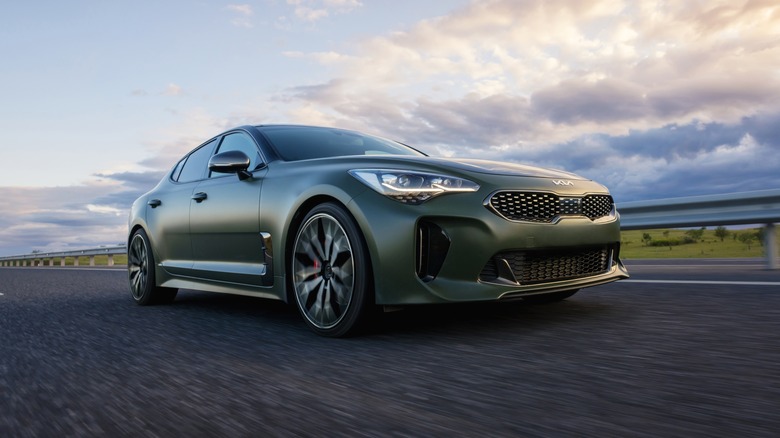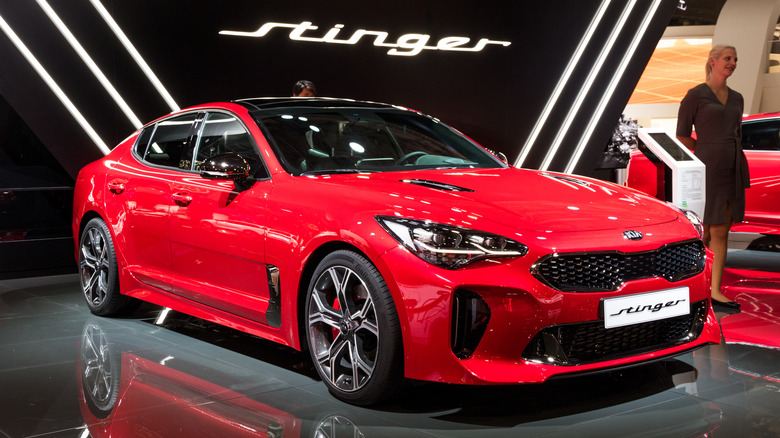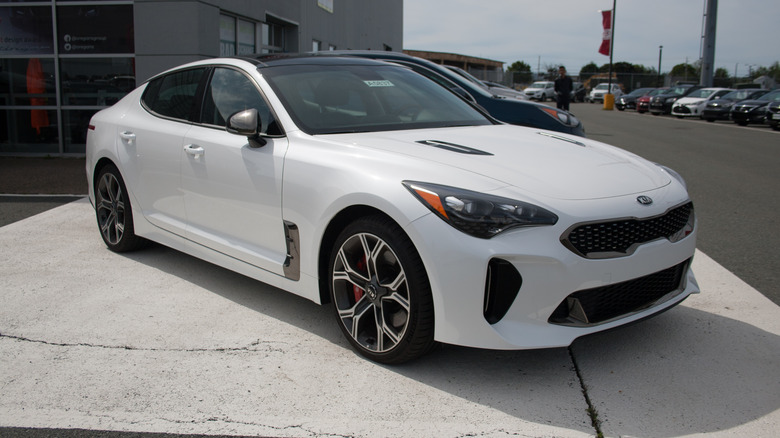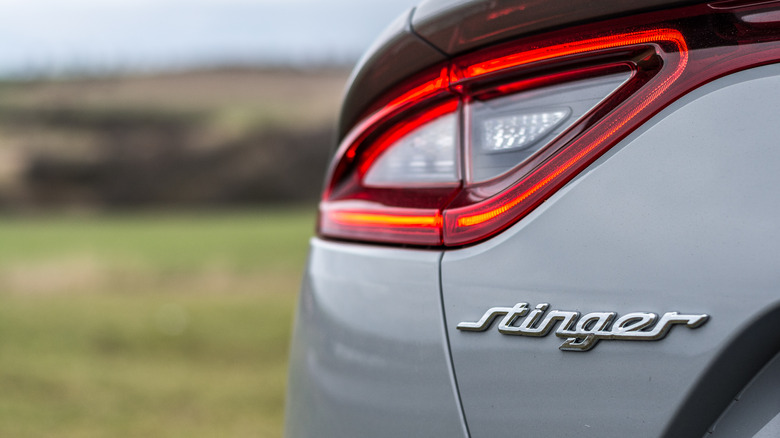Which Engines Were Used In The Kia Stinger Through The Years?
Not every vehicle that hits the market is going to have a long life. Yes, you could have something like the Ford F-Series that stretch back all the way to the 1940s, but not every car will have that kind of legacy. For example, take the Kia Stinger. This mid-size hatchback from the South Korean automaker debuted for the 2018 model year, and it was discontinued last year. You are looking at around five years or so of production, but that doesn't necessarily mean that this vehicle was a lemon. It actually received pretty good reviews upon release, but the issue always comes down to how many people bought it. In 2018, the first full year of production in the United States, it sold around 16,800 units. For comparison, the Kia Soul sold over 100,000 units. The Kia Stinger just didn't catch on, despite being a surprisingly affordable vehicle even in comparison to more budget-friendly Kias.
Despite the car's short lifespan, there were a surprising number of engines that were options to power it. If the idea of procuring a Kia Stinger on the open market is something that interests you, there are still engine and package decisions that you need to make before you do so. We are going to break down the four different engines that were available for the Kia Stinger over its five-year production run so you can get a sense of what kind of power you would be dealing with if you decide to get one.
Theta II 2.0L T-GDi
The base level, standard issue engine for the Stinger didn't even bear the Kia name. Kia Motors is owned by Hyundai, and like General Motors or any other large company, it utilizes its engines across various brands. In this case, this engine was the Hyundai Theta II 2.0L T-GDi. Not only was this the standard engine in the Stinger, but it continues to be the same for the Genesis G70. That is the luxury arm of Hyundai, so its engine in a Kia says a lot.
The Theta II, which would remain the car's standard engine for its whole lifespan, is an inline-four engine with a double overhead camshaft. In terms of power, it does pretty decent numbers for the Kia Stinger. The I4 was able to generate 255 hp and 260 lb ft of torque. That may not knock anyone's socks off, but for a small engine in a mid-size hatchback, those are numbers you could be happy with. This wasn't exactly meant to be a high-performance combination of elements. However, if you were someone who did want a bit more power under the hood, Kia had another option available for you at the launch of the vehicle as well.
Lambda II 3.3L T-GDi
Hyundai has many other engine families in its stable, along with the Theta I4 engines, and one of them is Lambda. This is a series of aluminum block V6 engines that the company has been using since 2005. The particular engine that was an option for the Kia Stinger was the Lambda II 3.3L T-GDi. While the Theta II was introduced across the Hyundai lineup in the 2018 model year, the same cannot be said for the Lambda II, as it predates the Kia Stinger by three years after being the standard engine you would get in a Genesis G90 full-size luxury vehicle.
This particular Lambda II V6 is a massive step up from the Theta II I4 in terms of power. While this is partly due to this just being a larger engine in general, it is also because this engine features twin turbochargers. As a result, it can have an output of 365 hp and 376 lb ft of torque. That is an over 100 hp increase from the standard engine, so if you were someone who really wanted to pack a surprising amount of power into the mid-size hatchback, the Lambda II was the way to do it. It would be the option as the top-performing engine for the Kia Stinger until its 2023 production end.
Smartstream 2.5L T-GDi
Starting in 2020, Kia began offering a third option for an engine in the Kia Stinger. The Theta II I4 and the Lambda II V6 operated at the two extremes of the power spectrum, and the company decided that a middle ground engine should be introduced. This is where Kia turned to the Hyundai Smartstream 2.5L T-GDi, which first entered production in the same 2020 model year. Like the Theta, this was still an inline-four engine, but with its larger displacement and turbocharger, it was able to deliver a bit more power to those who wanted it. This also bore true for a variety of different Genesises, like the G80 and GV70.
The aluminum block Smartstream I4 can generate 300 hp and 311 lb ft of torque, nestling right in the middle of the Theta and Lambda. While maximum power is nice for plenty of people, not everyone wants that kind of kick in their everyday passenger car. While these three engines were available in the United States during the Kia Stinger's production, there was still one more engine out there for some international markets that have a better relationship with a different kind of fuel than traditional gasoline.
R II 2.2L CRDi
In the United States, having a diesel powered engine in a mid-size car is a bit of an oddity, but in places like Europe and Kia's native South Korea, using diesel fuel is a far more common occurrence. To accommodate those markets, Kia also included a diesel option for the Stinger from its beginning through 2020. For this, the company turned to the Hyundai R engines, a series of inline-four diesels that go back to 2009. The version used for the Stinger was the R II 2.2L CRDi.
Despite its extra 0.2L of displacement compared to the Theta II I4, the R II could only generate 197 hp, which is quite a bit less than its gasoline-powered counterpart. However, what the diesel engine does accomplish is an impressive output of 325 lb ft of torque, which even outpaces the larger Smartstream engine. A major benefit of diesel is that it is a more efficient fuel than gasoline, so those who opted for the R II also have that perk to enjoy. For those who wanted a base level engine but preferred to use diesel, this was a very worthy alternative to the Theta II.




